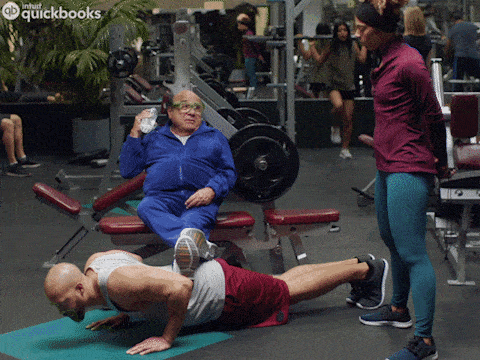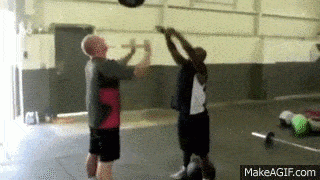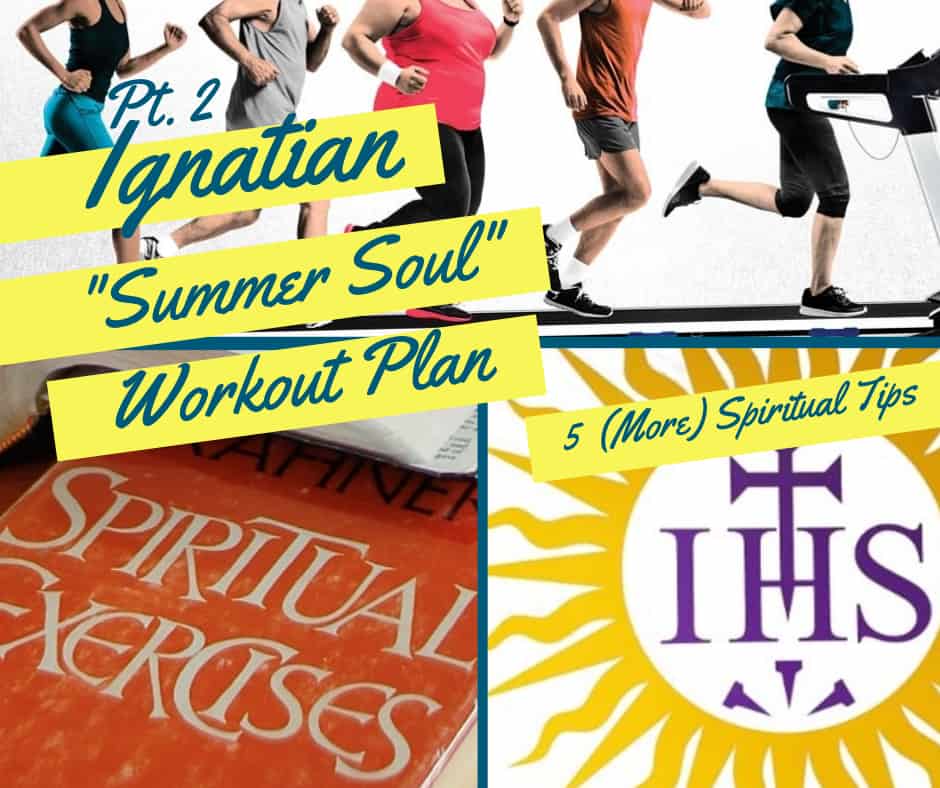Spiritual athletes, have you been whipping your soul into shape with the first five steps of the Ignatian “summer-soul” workout plan? [Click here for Part 1 if you missed it!]
If so, awesome. Keep it up!

If not, now’s the perfect time to renew the commitment for the second half of the summer.

Here are five more connections between physical and spiritual exercise, followed by a practical spiritual workout for each point.
As a reminder, don’t try to do them all at once. Start with one or two of the tips that you think will be most helpful for you and adapt them to your physical and spiritual needs.
Warning: The spiritual workout journey will be difficult, but totally worth it. Trust the process!
6.) Listen to the Music
I personally prefer to run on the treadmill with some base-bumping beats in my headphones to motivate. Just as listening to a certain song might make me run faster, music can have the same effect on our “spiritual workout.” Think of music as a great supplement to both physical and spiritual workouts. It can get both the physical and spiritual heart pumping. One word of caution: just as the act of listening to music is NOT the physical workout itself. Sometimes just listening to an inspiring, moving, or religious song does not necessarily mean you’ve prayed.

Spiritual Workout Tip: Try starting your prayer with an instrumental track that sets the mood for you. Just one soothing and calming song may be enough for you to mentally and spiritually prepare to enter into prayer. In fact, don’t be afraid to play a little music in the background while you pray if it helps you concentrate.
Check out this compiled list of songs, videos and articles that might help set the scene for your prayer. Try searching “Meditation music” on YouTube or create a playlist of songs on Spotify that really get your soul on fire for God. And if Spanish music moves you (as it does for me), you can always check out Fr. Cristobal Fones, SJ’s playlist of one of his latest albums: “Tu, mi hermano” (“You, My Brother”). And the spiritual beat goes on…
7.) Find Motivation When Times Get Tough
High school coaches often tell their athletes very fiercely: “If a day comes that you don’t want to workout or go to practice, that is precisely the day you most need to go.” I was told these exact words by my Jesuit spiritual director in high school about the practice of daily Mass. In other words, this same sentiment applies to both our athletic and spiritual life. The need for daily discipline and commitment to the team and to personal athletic development is required of any great athlete or team. Similarly, the grace of “disciplined” prayer, not done out of personal toughness or perfectionism, but out of a sense of real “commitment” to something or Someone greater than yourself is one of the greatest gifts bestowed by the practice of daily prayer. After all, love is not a feeling. Love is a choice. And that requires commitment.

Spiritual Workout Tip: Unite yourself in those moments of great resistance to prayer to the Passion of Christ. Jesus himself in the Agony in the Garden did not WANT to die on the cross, but freely chose to love at all costs.1 An older Catholic devotional I once read had a meditation where one contemplated why Jesus chose to die on the cross while in the Garden of Gethsemane. The author of this text creatively proposes that when the angel appeared to console Jesus, he saw “YOU” with him. Jesus chose to die for YOU– out of radical love for your particular soul. Think of that person, situation or purpose that will make you choose to pray or love at all costs. Is just being with God enough of a reason to pray? For some it might be, for others, they might need a little “tough love” to get them motivated.
8.) Get Yourself a Saintly Coach
Even professional athletes respond to the orders, advice and suggestions of a coach that has their best interest in mind. Growth is only possible when we are challenged to step out of our comfort zone. The same is true in our spiritual life when we use coaches or guides to help push us to grow. So don’t be afraid to take Jesus, Mary, or any other saint as your personal trainer or life coach. In fact, since very early on in life, Jesus himself had two coaches in Mary and Joseph. Who would have taught Jesus to work, pray, and love if not his own earthly parents? If Jesus was willing to take on a life coach for himself, who are we to say in our spiritual life, “I’m good. I’m my own coach.” While human nature might settle for that, sometimes it takes that other voice to remind us: “You can be better.”

Spiritual Workout Tip: Explore the lives of the saints and see if there is any one saint you would like to learn from or whom you identify with. In fact, you might want to remind yourself of your Confirmation Saint. Whichever saint you turn to, he or she can function as a life coach for your spiritual journey. This saint can be a source of strength that teaches you to do good.
Daily quotes from inspiring saints can provide just the right motivation needed to move beyond small personal projects and risk being part of a more universal project- building the “Kingdom of God.” Thanks for your words, Coach Iggy!
9.) Share Best Practices
Going to the gym might begin as an individual practice for the purposes of greater health, a more toned physique, or just because your doctor said so. But it might take on a new purpose once you begin to see the positive benefits of a healthy lifestyle. Once you have built a repertoire of techniques, skills, tips, and workout routines that work for you, you might be more willing to help another answer questions regarding their own health. Here’s the kicker, once you start experiencing the benefits of prayer, or begin growing in a life of greater freedom and charity, then your desire to share that gift with others increases exponentially. You will want to share it with all those you encounter. This is why your spiritual fitness no longer belongs exclusively to you.

Spiritual Workout Tip: Pray with the following Gospel passage. Jesus said to his disciples after the Sermon on the Mount: “You are the light of the world. A city set on a mountain cannot be hidden. Nor do they light a lamp and then put it under a bushel basket; it is set on a lampstand, where it gives light to all in the house. Just so, your light must shine before others, that they may see your good deeds and glorify your heavenly Father.”2 The ultimate source of the light in your life is God, NOT you. Thus, the end of prayer must always be to glorify God…and not to glorify yourself. Prayer is intimately bound to all those around us- which is why we pray for one another and have the communion of saints praying for and with all the Church.
10.) Don’t Be Afraid to Mix It Up
Studies in exercise science constantly point to avoiding “plateauing” or “stalling.” If you only do the same kind of exercise over and over your muscles adapt to certain exercises, and muscle growth stalls. A technique known as “muscle confusion” has been promoted by physical trainers to combat this effect.3 In essence, it’s all about changing your routine to keep your body engaged. This type of technique is key not just in the physical exercise realm, but in the spiritual as well. How often have you said that prayer is boring, repetitive, or tiring? Being creative in prayer is key to keeping the soul actively engaged.

Spiritual Workout Tip: Don’t be afraid to spice up your prayer life. While the universal Church gives us a specific Gospel passage to pray with every day of the year, we can’t be afraid to introduce our imagination into the mix. For instance, instead of just reading the Gospel passage of the Last Supper and meditating on the exact words, you might want to try a spiritual exercise technique known as “imaginative contemplation.” Place yourself within the scene and imagine yourself speaking to Christ during the first Eucharistic feast. Is there something you notice about Jesus’ gaze, hand gestures, tone of voice? Encounter God through actively engaging your imagination, and you might be amazed at the results.
You can also use a variety of different prayer styles. For example, the Rosary might help you connect with God. Or another of these time-tested methods of prayer, such as Lectio Divina, Meditation, Liturgy, Spiritual Reading, etc. As a spiritual trainer, Jesus is always ready to meet us exactly where we’re at, and in total freedom. So don’t get tied down to only one way of praying.
*****
In summary, three things are certain when doing any of these or other Spiritual Exercises:
- There is not a single second, minute or hour spent in intentional prayer before God that will not be used by God for our growth and spiritual well-being (whether we feel it or not).

- Prayer is not only powerful when you “feel” it, but rather its power lies more in actually “doing” prayer- because prayer is done by God first. In other words, it is more about opening ourselves to allow God to work in us. So when it comes to prayer (and I guess Nike athletics?)… Just do it!

- In the same way that a nutritional diet asks you to renounce consuming sugars, unsaturated fats, and bad cholesterol in exchange for a slimmer, happier and overall healthier lifestyle, the Spiritual Exercises have been described as learning to be “free from”… i.e. disordered affections, sins, past, etc. in order to become “free for”… i.e. doing God’s will, loving more radically, living fully alive, etc. This goal must always be at the forefront of any Spiritual Exercise.

If the goal of a “summer bod” is to get more eyes to look at our physical appearance, the goal of prayer and our “summer soul” is to allow God’s eyes to look upon our reality, creating a heart within us that resembles that of his Son, Jesus Christ.
This is the ultimate goal of any Ignatian prayer.
- Luke 22:42 – “Father, if you are willing, take this cup away from me; still, not my will but yours be done.” ↩
- Matthew 5:14-16. ↩
- Rick Ryan, an exercise specialist, explains the concept on Dialed In: “Muscle confusion is the need to change your workout routine periodically to keep the body stimulated and growing. If you follow the same routine for several weeks, your body will adapt to it. You need to confuse the muscles, so they do not anticipate what your next workout will be.” ↩


